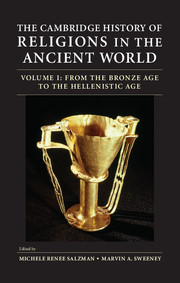Book contents
- Frontmatter
- Contents
- List of Figures and Maps
- List of Contributors
- List of Abbreviations
- Acknowledgments
- Introduction to Volumes I and II
- Introduction to Volume I
- Part I Mesopotamia and the Near East
- Part II Egypt and North Africa
- Part III Greece and the Eastern Mediterranean
- Part IV The Western Mediterranean and Europe
- Suggestions for Further Reading
- General Index
- Index of Citations
- Frontmatter
- Contents
- List of Figures and Maps
- List of Contributors
- List of Abbreviations
- Introduction to Volume II
- Part I Iran and the Near East
- Part II Egypt and North Africa
- Part III Greece and Asia Minor
- Part IV Italy, Roman Gaul, and Spain
- 14 Religion in Rome and Italy from the Late Republic through Late Antiquity
- 15 Judaism in Italy and the West
- 16 Christianity in Italy
- 17 Religions and Cities in Roman Gaul (First to Fourth Centuries CE)
- 18 Christianity in Gaul
- 19 Religions of Roman Spain
- Suggestions for Further Reading
- General Index
- Index of Citations
- References
16 - Christianity in Italy
from Part IV - Italy, Roman Gaul, and Spain
Published online by Cambridge University Press: 05 October 2013
- Frontmatter
- Contents
- List of Figures and Maps
- List of Contributors
- List of Abbreviations
- Acknowledgments
- Introduction to Volumes I and II
- Introduction to Volume I
- Part I Mesopotamia and the Near East
- Part II Egypt and North Africa
- Part III Greece and the Eastern Mediterranean
- Part IV The Western Mediterranean and Europe
- Suggestions for Further Reading
- General Index
- Index of Citations
- Frontmatter
- Contents
- List of Figures and Maps
- List of Contributors
- List of Abbreviations
- Introduction to Volume II
- Part I Iran and the Near East
- Part II Egypt and North Africa
- Part III Greece and Asia Minor
- Part IV Italy, Roman Gaul, and Spain
- 14 Religion in Rome and Italy from the Late Republic through Late Antiquity
- 15 Judaism in Italy and the West
- 16 Christianity in Italy
- 17 Religions and Cities in Roman Gaul (First to Fourth Centuries CE)
- 18 Christianity in Gaul
- 19 Religions of Roman Spain
- Suggestions for Further Reading
- General Index
- Index of Citations
- References
Summary
There were, of course, no Christians in Italy during the principate of Augustus (27 BCE to CE 14), when the public religion of the Romans was being recast and revitalized in tandem with the political and social institutions of the emerging imperial system. Some four and a half centuries later, however, when a bishop of Rome was said to have turned back an invading Hunnic warlord and successfully negotiated with a Vandal king before the gates of his defenseless city, Christianity was the officially sanctioned religion of Rome and Italy. Between these two poles lies, it would seem, a remarkable success story. But the rise of Christianity is a tale marked by deep continuities as well as spectacular contrasts. Pope Leo I’s (440–61) alleged victory over Attila and mollification of Gaiseric share certain fundamental assumptions with Augustus’s enlistment of the traditional Roman gods in the project of the reconstituted empire. Like many early imperial Romans, many late ancient Romans, too, viewed proper cultivation of the divine as prerequisite to public, as well as personal, welfare. To be sure, by the mid-fifth century the divine power in question was significantly different: Augustus’s Rome of Jupiter and Mars and Apollo had become the Rome of Christ, the apostles, and the martyrs, while churches and the memorials of saints now defined a cityscape once commanded by temples and imperial fora. Yet, as Augustus had displayed statues of the heroes of the legendary and recent past in his new Forum, Leo ordered that Rome’s churches be decorated with biblical cycles and declared that Peter and Paul had ousted Romulus and Remus as the city’s guardians. And although by Leo’s day the populace of Rome, like that of most Italian cities, largely regulated its ceremonial life by an annual cycle of festivals keyed to the life of Christ and the deaths of the saints, not by holidays linked to the history and legends of a fading age, those same Christian feast days frequently coincided with or overwrote earlier celebrations.
- Type
- Chapter
- Information
- The Cambridge History of Religions in the Ancient World , pp. 421 - 445Publisher: Cambridge University PressPrint publication year: 2013



